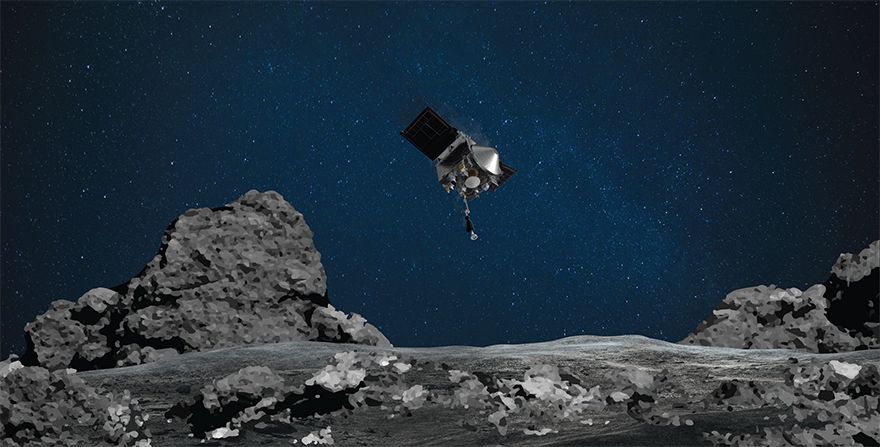 Photo: NASA/Goddard/University of Arizona
Photo: NASA/Goddard/University of ArizonaA
NASA mission, that began on 8 September 2016, to collect dust and pebble samples from an asteroid, reached a historic moment yesterday when the Origins, Spectral Interpretation, Resource Identification, Security, Regolith Explorer (OSIRIS-REx) spacecraft, unfurled its robotic arm to briefly ‘touch’ the surface of Bennu 200 million miles away from Earth.
This particular ancient asteroid was chosen as it offers scientists a window into the early solar system as it was first taking shape billions of years ago and flinging ingredients that could have helped seed life on Earth.
If the sample collection event, known as “Touch-And-Go” (TAG), provided enough of a sample, mission teams will command the spacecraft to begin stowing the precious primordial cargo to begin its journey back to Earth in March 2021. Otherwise, another attempt will be made in January.
OSIRIS-RExAt arrived at Bennu on 3 December 2018 and began orbiting the asteroid. Yesterday at 1:50pm (EDT), the spacecraft fired its thrusters to nudge itself out of orbit around Bennu. It extended the shoulder, then elbow, then wrist of its 11ft sampling arm, known as the Touch-And-Go Sample Acquisition Mechanism (TAGSAM), and transited across Bennu while descending about a half a mile towards the surface.
After a 4hr descent, at an altitude of approximately 410ft, the spacecraft executed the “Checkpoint” burn, the first of two manoeuvres to allow it to precisely target the sample collection site, known as “Nightingale.”
The spacecraft fired its thrusters for the second “Matchpoint” burn 10min later to slow its descent and match the asteroid’s rotation at the time of contact. It then continued a treacherous, 11min coast past a boulder the size of a two-story building, nicknamed “Mount Doom,” to touch down in a clear spot in a crater on Bennu’s northern hemisphere.
The Nightingale site is one of the few relatively clear spots on this unexpectedly boulder-covered space rock.
Thomas Zurbuchen, associate administrator for NASA’s Science Mission Directorate, said: “This was an incredible feat – and we have advanced both science and engineering and our prospects for future missions to study these mysterious ancient storytellers of the solar system.
“A piece of primordial rock that has witnessed our solar system’s entire history may now be ready to come home for generations of scientific discovery, and we can’t wait to see what comes next.”
All spacecraft telemetry data indicates the TAG event executed as expected. However, it will take about a week for the OSIRIS-REx team to confirm how much sample the spacecraft collected.
Real-time data indicates the TAGSAM successfully touched the surface and fired a burst of nitrogen gas. The gas should have stirred up dust and pebbles on Bennu’s surface, some of which should have been captured in the TAGSAM sample collection head. OSIRIS-REx engineers also confirmed that shortly after the spacecraft made contact with the surface, it fired its thrusters and safely backed away from Bennu.
Lori Glaze, NASA planetary science division director, said: “The TAG manoeuvre was historic. The fact that we safely and successfully touched the surface of Bennu, in addition to all the other milestones this mission has already achieved, is a testament to the living spirit of exploration that continues to uncover the secrets of the solar system."
The spacecraft is scheduled to return to Earth on 24 September, 2023, when it will parachute the SRC into Utah's west desert where scientists will be waiting to collect the asteroid samples.